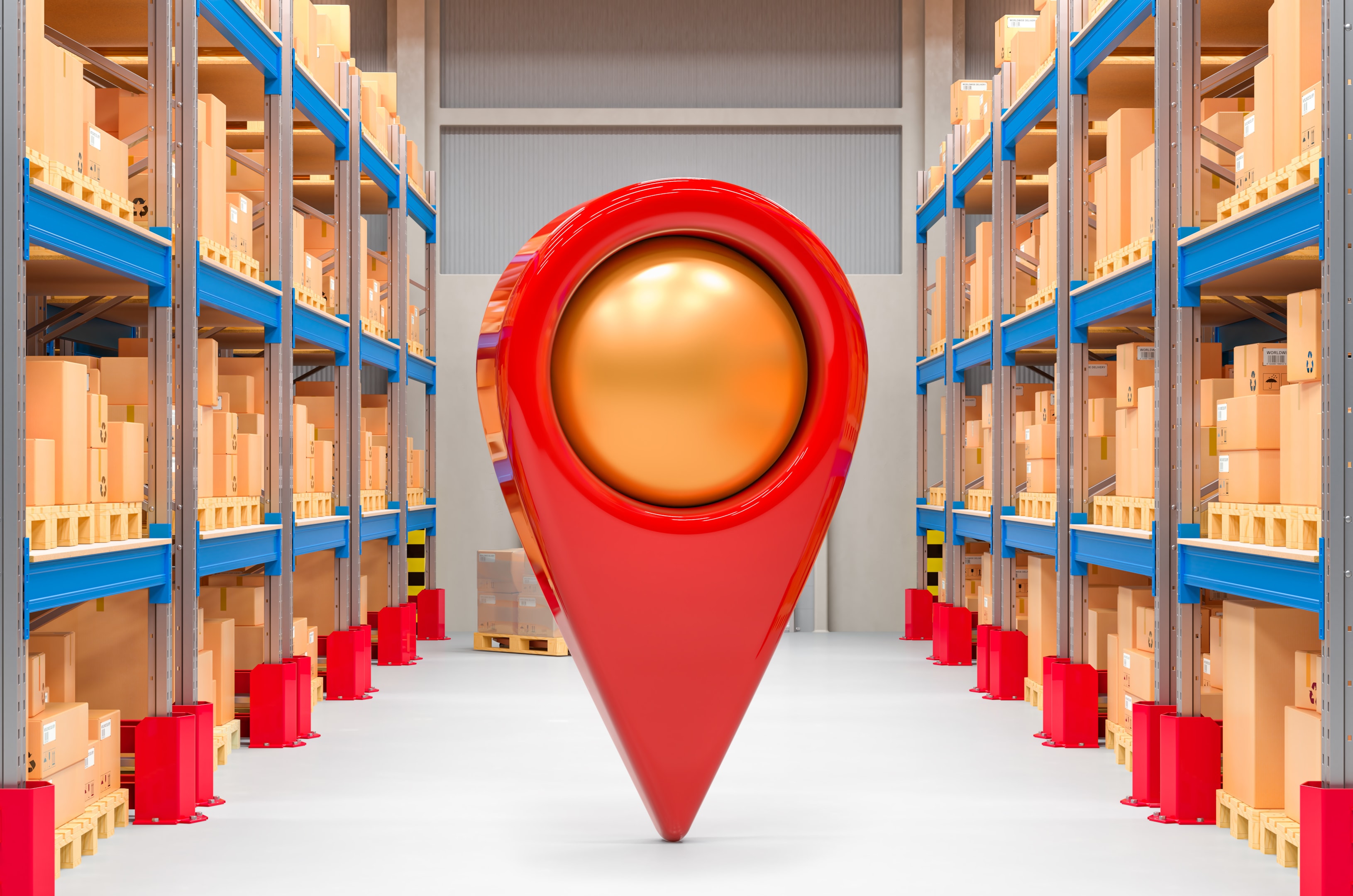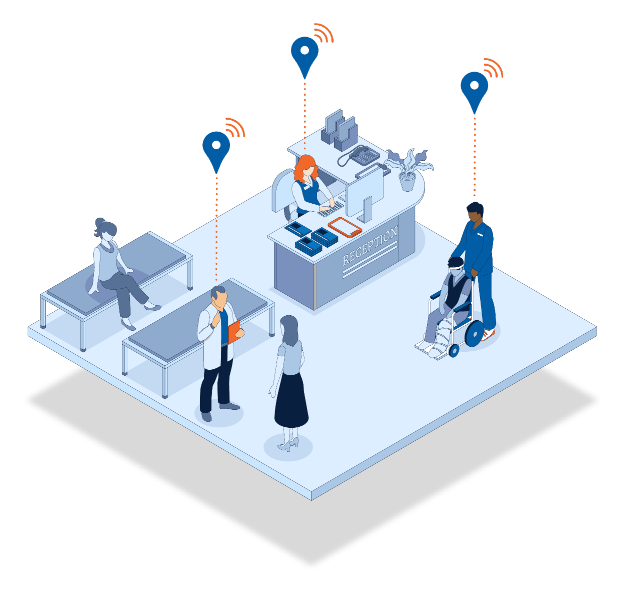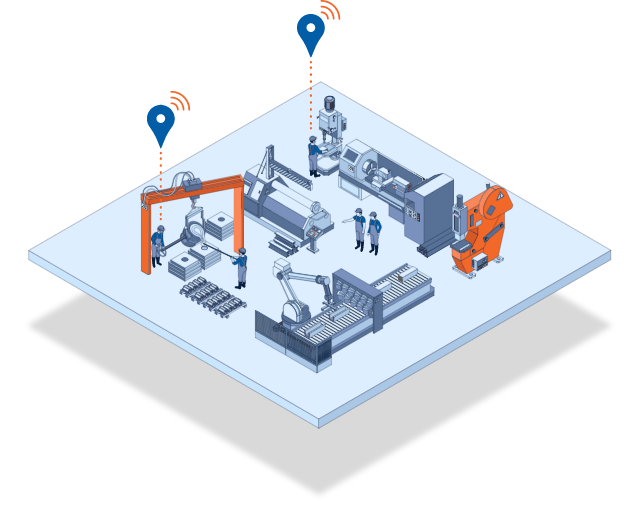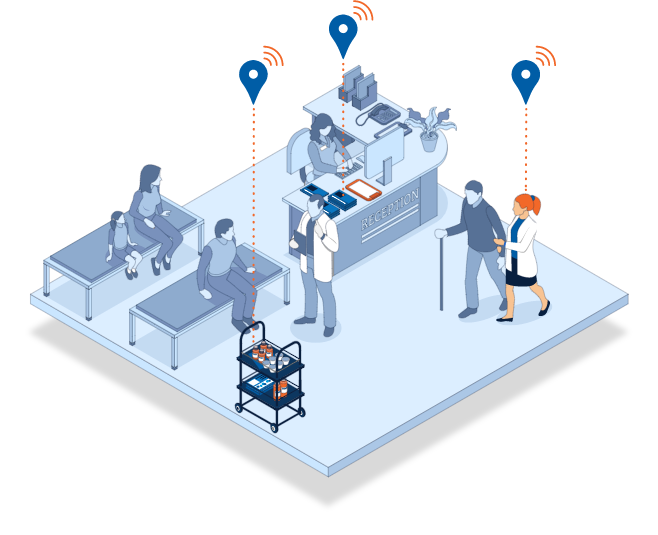Indoor tracking, often referred to as indoor GPS or indoor positioning, is the process of locating and monitoring people, assets, or objects within enclosed environments such as hospitals, warehouses, or office buildings. Unlike traditional GPS, which struggles with signal accuracy indoors, indoor positioning systems are specifically designed to overcome these challenges by using advanced technologies to deliver precise location data. These systems leverage a network of electronic devices and software to detect and track movement, enabling applications such as real-time navigation, asset tracking, safety alerts, and operational analytics. By harnessing indoor tracking, organizations can enhance efficiency, improve safety, and deliver personalized experiences within their indoor environments.

Why is Indoor Tracking Important?
Indoor tracking is vital for optimizing workflows, ensuring safety, and improving operational efficiency. By enabling real-time visibility of resources, organizations can streamline processes, enhance security, and reduce costs associated with misplaced assets or inefficiencies. Additionally, indoor localization is crucial in detecting objects within buildings where traditional GPS is ineffective, using technological infrastructure such as beacons and tags.
This article explores the concept of indoor tracking, highlights its importance, and demonstrates how Real-Time Location Systems (RTLS) enhance their capabilities to transform businesses across industries.
Understanding Indoor Tracking Systems

Indoor tracking refers to the use of technology to pinpoint the location of objects or individuals inside a facility. It leverages technologies such as Bluetooth Low Energy (BLE), Wi-Fi, Ultra-Wideband (UWB), and RFID to provide real-time location data. Mobile devices, like smartphones, play a crucial role in accurately locating people or objects in environments where traditional GPS fails.
How Does Indoor Tracking Work?
- Tags or sensors are attached to assets or worn by individuals.
- These tags communicate with receivers or gateways located throughout the building using technologies like RFID, Bluetooth, and ultra-wideband.
- Data is processed by a central platform, enabling real-time visualization and insights. This system accurately detects movements and provides real-time location data within buildings, making it crucial for various applications, including manufacturing and marketing solutions.
How Indoor Positioning Systems Work
Indoor positioning systems work by using a network of electronic devices and connected software to analyze position data. These systems employ technologies like RFID, Bluetooth, Wi-Fi, and ultra-wideband (UWB) to determine the location of objects or people within a building. The process typically involves the following steps:
- Tagging: Devices or objects are equipped with tags or sensors that transmit signals to a network of receivers or anchors.
- Signal Reception: The receivers or anchors capture the signals and send them to a location engine software.
- Data Analysis: The software analyzes the signals and calculates the exact location of each device or object.
- Visualization: The location data is then displayed on a digital map or used for various applications such as navigation, tracking, and analytics.
This multi-step process ensures that indoor positioning systems provide accurate and real-time location data, enabling businesses to optimize their operations within indoor environments.
Technologies Used in Indoor Positioning

Several technologies are used in indoor positioning systems, each offering unique advantages:
- Wi-Fi: Wi-Fi-based indoor positioning systems use the strength of Wi-Fi signals to determine the location of devices. This method leverages existing network infrastructure, making it cost-effective and easy to deploy.
- Bluetooth Low Energy (BLE): BLE-based systems use the proximity of BLE beacons to determine the location of devices. These systems are energy-efficient and scalable, ideal for large deployments.
- Ultra-Wideband (UWB): UWB-based systems use the time of arrival of UWB signals to determine the location of devices with high accuracy. This technology is perfect for critical tracking needs where precision is paramount.
- RFID: RFID-based systems use the proximity of RFID tags to determine the location of objects. These systems are effective for passive or semi-active asset tracking.
- Li-Fi: Li-Fi-based systems use light to transmit data and determine the location of devices. This emerging technology offers high-speed data transmission and precise location tracking.
By integrating these technologies, indoor positioning systems can provide robust and versatile solutions for various indoor tracking needs.
Applications of Indoor Tracking

Healthcare
- Locate critical equipment such as ventilators or infusion pumps.
- Track patients, ensuring safety and timely care.
- Enhance workflow by optimizing staff allocation during emergencies.
- Utilize indoor navigation systems for directing patients and staff within hospitals.
Manufacturing and Warehousing
- Track inventory and tools in real-time, ensuring efficient operations.
- Utilize real-time location tracking to monitor worker locations in hazardous areas, enhancing safety.
Retail and Hospitality
- Improve customer experiences with personalized, location-based services.
- Track staff movements to ensure timely service delivery.
Education
- Monitor attendance and ensure the safety of students and staff.
- Manage and locate educational resources across large campuses.
Challenges of Indoor Tracking
Despite its advantages, indoor tracking faces challenges, including:
- Signal Interference: Walls, furniture, and electronic devices can disrupt signals. Local positioning systems can mitigate signal interference and improve accuracy in indoor tracking.
- Privacy Concerns: Tracking individuals raises questions about data security and consent.
- Complex Environments: Indoor spaces are often complex and dynamic, with varying layouts and materials.
How RTLS Enhances Indoor Tracking
Real-Time Location Systems (RTLS) are advanced solutions designed to track and monitor the real-time location of people and assets within indoor environments. RTLS offers several enhancements over traditional indoor tracking.
Outdoor Tracking
RTLS can track objects or people both indoors and outdoors, using technologies like GPS for outdoor environments. This capability is beyond the scope of indoor tracking systems, which are confined to indoor spaces
Real-Time Data
RTLS provides continuous, real-time location data, allowing for instant updates on the position of assets or personnel. Indoor tracking systems may not always offer real-time updates.
Geo-Fencing
RTLS can define virtual boundaries (geo-fences) in both indoor and outdoor spaces. This feature is useful for security, safety, and operational efficiency, such as preventing unauthorized access to certain areas
Broad Applications
RTLS is used in a wide range of industries, including logistics, healthcare, manufacturing, and retail. It can track assets, inventory, and personnel across various environments, providing a more comprehensive solution compared to indoor tracking
Enhanced Visibility
RTLS offers improved visibility and transparency across entire operations, helping businesses optimize processes, enhance safety, and reduce costs
AiRISTA’s RTLS Solutions for Indoor Tracking
AiRISTA leads the industry in providing innovative RTLS solutions tailored for indoor tracking. Their technologies improve operational efficiency, safety, and resource visibility. AiRISTA’s RTLS solutions also contribute to the development of smart buildings by enhancing operational efficiency and user experience within large indoor environments.
Key Products and Solutions:
- RTLS Tags: Wi-Fi and BLE-enabled tags track assets and individuals with high accuracy, supporting real-time location updates and advanced features like accelerometers for movement detection.
- Environmental Sensors: Monitor conditions such as temperature and humidity in sensitive areas, ensuring compliance with safety standards.
- Sofia Software Platform: AiRISTA’s powerful software platform processes data from tags and sensors, delivering actionable insights and enabling workflow automation.
Benefits of AiRISTA’s RTLS in Indoor Tracking
AiRISTA RTLS enhances indoor tracking by providing:
- Application Specific: Use cases and settings for specific scenarios like Staff Safety, Patient Flow, Asset Tracking and others for fast deployment. The RTLS solutions are versatile and can be applied across various industries, including healthcare, manufacturing, logistics, and education.
- Real-Time Monitoring: AiRISTA offers real-time location insights, allowing businesses to monitor assets, personnel, and processes continuously. This helps in making timely decisions and improving operational efficiency.
- Enhanced Security and Safety: By providing precise location data, AiRISTA’s RTLS can enhance security and safety within facilities. For example, it can help in monitoring restricted areas, ensuring personnel safety, and managing emergency responses effectively.
- Actionable Insights: The platform provides actionable insights through dashboards, reports, and mapping tools. These insights help businesses optimize processes, improve asset utilization, and enhance overall productivity.
- Easy Integration: AiRISTA’s RTLS solutions are designed to integrate seamlessly with existing systems and infrastructure, making deployment straightforward and minimizing disruptions.
Use Cases of AiRISTA’s RTLS in Asset Tracking
- Healthcare: Ensure the availability of critical medical equipment. Monitor patient safety and staff efficiency during emergencies. Indoor location tracking helps monitor the movement of patients and staff within hospitals, leveraging beacons or tags to provide real-time data and enhance operational efficiency.
- Manufacturing: Track tools and materials to maintain production timelines. Enhance worker safety by monitoring activity in hazardous zones.
- Retail and Hospitality: Improve customer satisfaction through location-based promotions and navigation. Monitor staff performance and enhance operational flow.
The Future of Indoor Navigation with RTLS
The future of indoor tracking is bright, with RTLS playing a pivotal role:
- AI Integration: Predictive analytics will anticipate trends and optimize workflows.
- IoT Expansion: More connected devices will enhance tracking capabilities.
- Standardization: Widespread adoption of RTLS will drive uniformity across industries.
Summing Up the Impact of Indoor Tracking
Indoor tracking is transforming how businesses operate, providing real-time insights into asset and personnel locations. By leveraging RTLS, organizations can overcome the challenges of indoor environments and unlock unprecedented levels of efficiency, safety, and visibility.
AiRISTA’s cutting-edge RTLS solutions empower industries to modernize their indoor tracking capabilities and stay ahead of the curve. Ready to explore the future of tracking? Discover AiRISTA’s solutions today!





